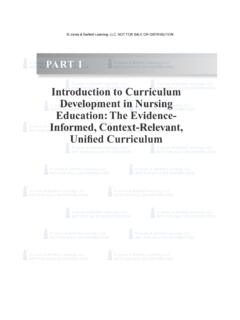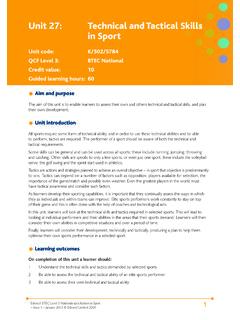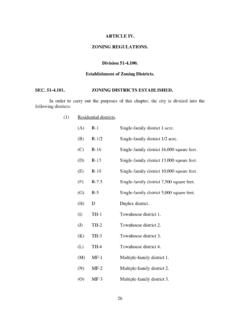Transcription of Organizational Identity and Its Implication on ...
1 803 Organizational Identity and Its Implication on Organization development Yu e h - Y s e n L i n University of Minnesota Organizational Identity is defined as a set of statements that organization members perceive to be central, distinctive, and enduring to their organization (Albert & Whetten, 1985). It is influential to behaviors of both leaders and members in many aspects within an organization. By reviewing current theoretical and empirical literature, this article integrates several research directions of Organizational Identity in order to delineate the relationship between Organizational Identity and Organizational development and change.
2 implications and possible directions for future research are discussed as well. Keywords: Organizational Identity , planned Organizational Change, Organization development For the last decade, Organizational Identity has emerged as a new focus in Organizational research. Organizational Identity is defined as an enduring, distinctive, and central statement perceived by an organization s members (Albert & Whetten, 1985) to answer questions such as Who are we? What are we doing? What do we want to be in the future? Research of Organizational Identity focuses on several dimensions, such as the formation of Organizational Identity , and its relationship to Organizational culture and image (Ashforth & Mael, 1989; Gioia, Schultz, & Corley, 2000; Hatch & Schultz, 2002), multiple identities and Identity management (Albert & Whetten, 1985; Pratt & Foreman, 2000), and Identity and Organizational change (Brown & Starkey, 2000; Dutton & Dukerich, 1991).
3 Organizational Identity is important since it affects actions, interpretation, and decision making of Organizational members and the management. Several studies also show that Organizational Identity has a huge impact on Organizational change processes. This paper attempts to address the following questions. What is Organizational Identity ? How does Organizational Identity affect Organizational change? Is it a barrier that hinders an organization s change plan? Can it be a means for organizations to facilitate planned change processes? In this paper, I focus on the influence of Organizational Identity on planned change process, or organization development (OD), which is referred to any kind of planned , system-wide, managed, and behavioral-scientific change effort initiated by the management or change agents in order to improve an organization s effectiveness and performance through planned interventions (Beckhard, 1969).
4 A planned change process is different from other kinds of Organizational change processes ( life cycle, evolution, dialectic, see Van de Ven & Poole, 1995) by some distinctive characteristics, such as its goal orientation, adaptation through strategic choices, and single organization as the unit of change (Van de Ven & Poole,1995). The purpose of this paper is to delineate the relationship between Organizational Identity and planned Organizational change. By reviewing current literature and research regarding Organizational Identity , this paper presents a general picture about Organizational Identity and its influential role within an organization.
5 It also articulates the importance of Organizational Identity to Organizational planned change processes. This paper contains three sections. First, the definition of Organizational Identity , its influence on organizations, its formation, as well as its relationship with Organizational culture will be introduced. Second, the influence of Organizational Identity on Organizational change process, both positive and negative, will be discussed. Last, a holistic framework of the relationship between Organizational Identity and planned Organizational change is proposed. Possible directions for future research are addressed in the conclusion section, as well.
6 Organizational Identity Definition of Organizational Identity Albert and Whetten (1985) define Organizational Identity as a set of statements that organization members perceive to be central, distinctive, and enduring to their organization. The definition reveals three critical criteria: centrality, distinctiveness, and durability. Centrality means that the statement should include features that are important and essential to the organization. Identity as a statement of central characters defines what is important and essential to the organization. (Albert & Whetten, 1985). The criterion of distinctiveness emphasizes that the Identity statement should be able to distinguish the organization from others.
7 A distinctive Identity statement usually includes Organizational ideology, management philosophy, and culture. It helps the organization locate itself in a specific classification. The character of durability Copyright 2004 Yueh-Ysen Lin 37-2 804emphasizes the enduring nature of Organizational Identity . It implies that Organizational change is difficult to start because the loss of Organizational Identity will have strong impact on the organization (Albert & Whetten, 1985). Influence of Organizational Identity According to the definition, an Identity statement is collectively and cognitively held by organization members to answer questions such as Who are we?
8 What business are we in? and What do we want to be? Organizational Identity influences both leaders and members within an organization. For Organizational leaders, Organizational Identity is influential on their decision making activities within an organization. Typically, Identity questions surface and attract the management s attention when they cannot find easier, more specific, and more quantifiable solutions regarding specific Organizational issues (Albert & Whetten, 1985). By defining the organization s Identity , Organizational leaders establish a fundamental base that serves as the guide for them to engage in decision making activities (Albert & Whetten, 1985) Organizational members are affected by an organization s Identity as well.
9 Since social Identity theory suggests that individuals have the natural tendency to identify with social groups and define themselves with the connection with these groups (Pfeffer & Salancik, 1978), Organizational members answers to Identity questions have strong influences on their judgment of and identification with their organizations (Albert & Whetten, 1985). This identification in turn affects the establishment and maintenance of members self-esteem (Humphrey & Brown, 2002). Organizational Identity provides Organizational management and members with a key lens for their interpretation and sensemaking about occurring events for their Organizational life (Dutton & Dukerich, 1991; Elsbach & Kramer, 1996).
10 The results of member interpretation and sensemaking direct members behaviors and actions within the organization (Dutton & Dukerich, 1991). Formation of Organizational Identity Based on the Identity interaction model and individual Identity theory (Cooley, 1922; Erickson, 1968; Goffman, 1959; Mead, 1934), Albert and Whetten (1985) argue that interaction and comparison with other organizations are keys to the formation of Organizational Identity . Similar to individual Identity , the formation of Organizational Identity is a process of ordered interorganizational comparisons (Albert, 1977). During the processes, members constantly compare their own organization with target organizations and obtain evaluative information from other parties which, in turn, affect members definition and Identity of their own organization.
















